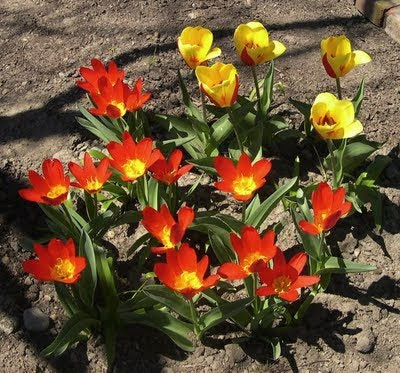Critter-Proofing Fall Bulbs
“I’ve tried bulbs, but the squirrels dig them up.”
“I planted tulips last year, but nothing came up in the spring. I think something ate the bulbs.”
“The deer and bunnies get my tulips every spring. I love them, but it’s just not worth it.”

 Spray tulips with Liquid Fence repellent to keep deer and bunnies from eating them. Shown here are two early blooming varieties, Stresa and Scarlet Baby.
Spray tulips with Liquid Fence repellent to keep deer and bunnies from eating them. Shown here are two early blooming varieties, Stresa and Scarlet Baby.
Foil bulb-eating critters by planting daffodils, grape hyacinths (muscari) and other bulbs that deer, chipmunks and rabbits tend to avoid.
Sound familiar? If you’re ready to try again, I’ve got some tried-and-true tips to beat the bulb-eating critters in your yard.
Tactic #1. Know your adversary.
Squirrels are fearless and curious, but have a relatively short attention span. They dig up bulbs right after you plant them.
Deer eat what’s convenient and are creatures of habit. They tend to remember the location of the salad bar, but they’re wary of new scents and sounds or anything out of the ordinary. They nip the flower buds in the spring.
Chipmunks and voles dig tunnels, especially through soft soil. They eat bulbs after you plant them, usually in the fall or early spring.
Rabbits are nervous and constantly on the lookout for potential predators. They eat the leaves and flowers in the spring.
Tactic #2. Use your adversary’s weakness to your advantage.
Squirrels notice newly disturbed soil and love to dig in it. Disguise your planting spots by covering them with rocks, buckets, boards, chicken wire or anything else you have lying around. Pick up the camouflage after the ground freezes.
Deer don’t bother with bulbs until they come up in the spring. As soon as the tulips push through the ground, cover them with an arch or circle of wire mesh to prevent deer from getting a taste. Alternatively, spray the plants and surrounding ground with Liquid Fence or a similar product that deer find repugnant.
Chipmunks and voles don’t like to tunnel into rocky soil or through hard, sharp terrain. Surround tasty crocus and tulip bulbs with sharp gravel or oyster shell or plant them inside a wire cage. Apply a foul-smelling deterrent in the planting hole to trick the varmints.
Rabbits are spooked by the threat of predators and tend to avoid areas where they sense danger. In the spring, as soon as the bulbs come up, spray repellents, such as Liquid Fence or predator urine. In areas with lots of bunnies, surround your tasty tulips with a circle of wire mesh.
Tactic #3. Plant unappealing bulbs.
Animals won’t eat daffodils, alliums, fritillaries, grape hyacinths, and many other spring-flowering bulbs. As an added bonus, most of these bulbs increase and naturalize, becoming more beautiful each year.
Don’t give up! You can beat the critters and have lovely tulips and crocus next spring.
Print this Article:
Get the Dirt
Stay up to date on new articles and advice. Please fill out the information below.

